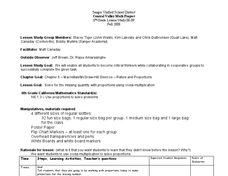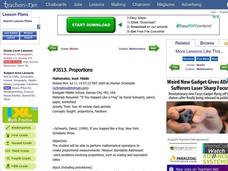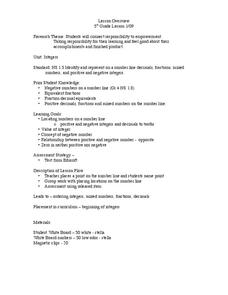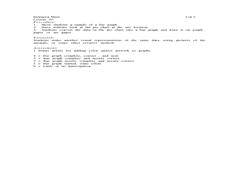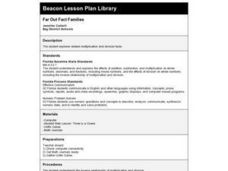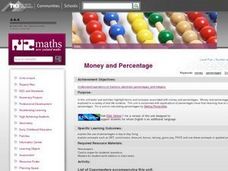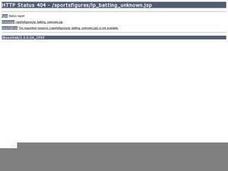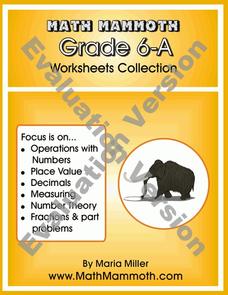Curated OER
To Quote or Not to Quote
Introduce your middle and high schoolers to the correct use of quotation marks. They identify examples of correct and incorrect quotations in magazines and edit a paragraph in groups. Use this lesson as a way to reinforce proofreading...
Curated OER
Using Proportions to Solve Problems
Skittles and math? Pupils will work as a class to determine how many orange Skittles are in a large bag by using proportions. They will problem solve, estimate, and share their thinking. Then, they will each receive a small bag of...
Curated OER
Triangular Numbers
In this geometry learning exercise, 10th graders calculate the total triangular number, which-is equal to all the dots it takes to make a triangle. There are 8 different questions asking you to find the triangular number for different...
Curated OER
Crispy Cookie Class Fundraiser
Seventh graders see the relationship of math and the real world application by manufacturing a product for making a profit. They create a food product from a recipe, record their sales and analyze and report their gross profit.
Curated OER
Proportions
Students perform mathematical operations to create proportional measurements, after listening to the David Schwartz book, If You Hopped Like a Frog.
Curated OER
Proportion
Students investigate proportion and ratio. In this geometry lesson plan, students set up the ratios of proportions correctly and solve for the unknown. They relate it to word problems.
Curated OER
Buggin' Out (Identifying and Adding Amounts of Money)
Students explore consumer math by participating in estimate exercises. In this currency lesson, students identify and define each piece of U.S. currency and their value to the monetary system. Students complete several money worksheets...
Curated OER
Numbers Beyond Reason!
Fourth graders use the story of the discovery of irrational numbers to explore the different classes of numbers, the different ways in which numbers may be represented, and how to classify different numbers into their particular class.
Curated OER
Ratio Basketball
Students, in teams of four, practice shooting free throws while mentally converting the ratio of shots made to those thrown into a percent. They chart and record the ratio, decimal and actual percentage earned after each round.
Pennsylvania Department of Education
Freckle Face
Students collect and record data. In this early data analysis lesson, students gather data about their partners face. As a class, the students use tally marks and pictographs to record the data and answer question about the information...
Curated OER
Integers
Using a simple technique, learners practice identifying integers on a number line. As numbers, both positive and negative, are pointed to, they name them. This could be part of anticipatory set before a lesson on integers.
Curated OER
Circle Up Your M&Ms
Fifth graders estimate how many M&Ms are in a pre-counted bag. They determine how many colored M&Ms are in a bag, then decide which of the two, bar graph or circle graph (in this case, circle graph) would be best to show te results.
Curated OER
End of the Year Math Terms
In this end of the year math test learning exercise, 4th graders complete problems including addition, division, measurement, decimals, and more. Students complete 22 problems.
Curated OER
More Pizzas and Things
Students are introduced to the problem by playing a guessing game of "I am a number, which is half of 6 and 6, what am I?" They explain their answers and see if anyone else had an alternate solution checking for reasonableness.
Curated OER
Graph a Panther's Diet
Students examine the diet of panthers. In this interpreting data lesson, students collect data on the panther's diet and chart the data in bar and pie graphs.
Curated OER
Far Out Fact Families
Second graders explore related multiplication and division facts. They study the inverse relationship of multiplication and division and engage in a group discussion about families. They complete a web-based lesson plan which is imbedded...
Curated OER
Money and Percentage
Fifth graders examine use of percentages in real world situations. They complete worksheet about using percentages after reviewing the concept. They look through newspapers to find examples of percentages used over the course of three...
Curated OER
Mathematics Within: Algebraic Patterns
Students investigate the concept of using proportions to compare quantities while also practicing calculations for foreign exchange rates. They develop the skill of solving for unknown quantities of money while using an algebraic equation.
Pennsylvania Department of Education
Extending Pattern Understandings
Students use shapes and manipulatives to demonstrate patterns. In this patterns lesson plan, students also break up patterns to identify a pattern unit.
Curated OER
Batting the Unknown
Learners use batting averages to provide a measure of a player's past success. They use Algebra to calculate required performance to improve the average. Students compare baseball batting statistics early in the season and late in the...
Curated OER
A Recipe For Success
Sixth graders explore a relevant application of ratios and proportions. They apply this concept through guided practice and interactive feedback.
Curated OER
Are You a Radical or Just a Square Root?
Fourth graders discover that the inverse of squaring is finding a square root. and that square roots are found in many formulas used in many disciplines. They utilize a worksheet imbedded in this plan that gives them quite a bit of...
Curated OER
Money Circulation: A Story of Trade and Commerce
Students are introduced to the meaning, symbolism, and value of the quarter. They determine the percentage of total monetary value held in quarters and graph the results. Students infer about the U.S. Mint's distrubution of coins. They...
Curated OER
Simple Past-Positive Sentences #2
In this simple past tense worksheet, students use words and phrases given to form positive sentences in the given tense. Answers may be submitted online for review. ESL appropriate but not exclusive.

